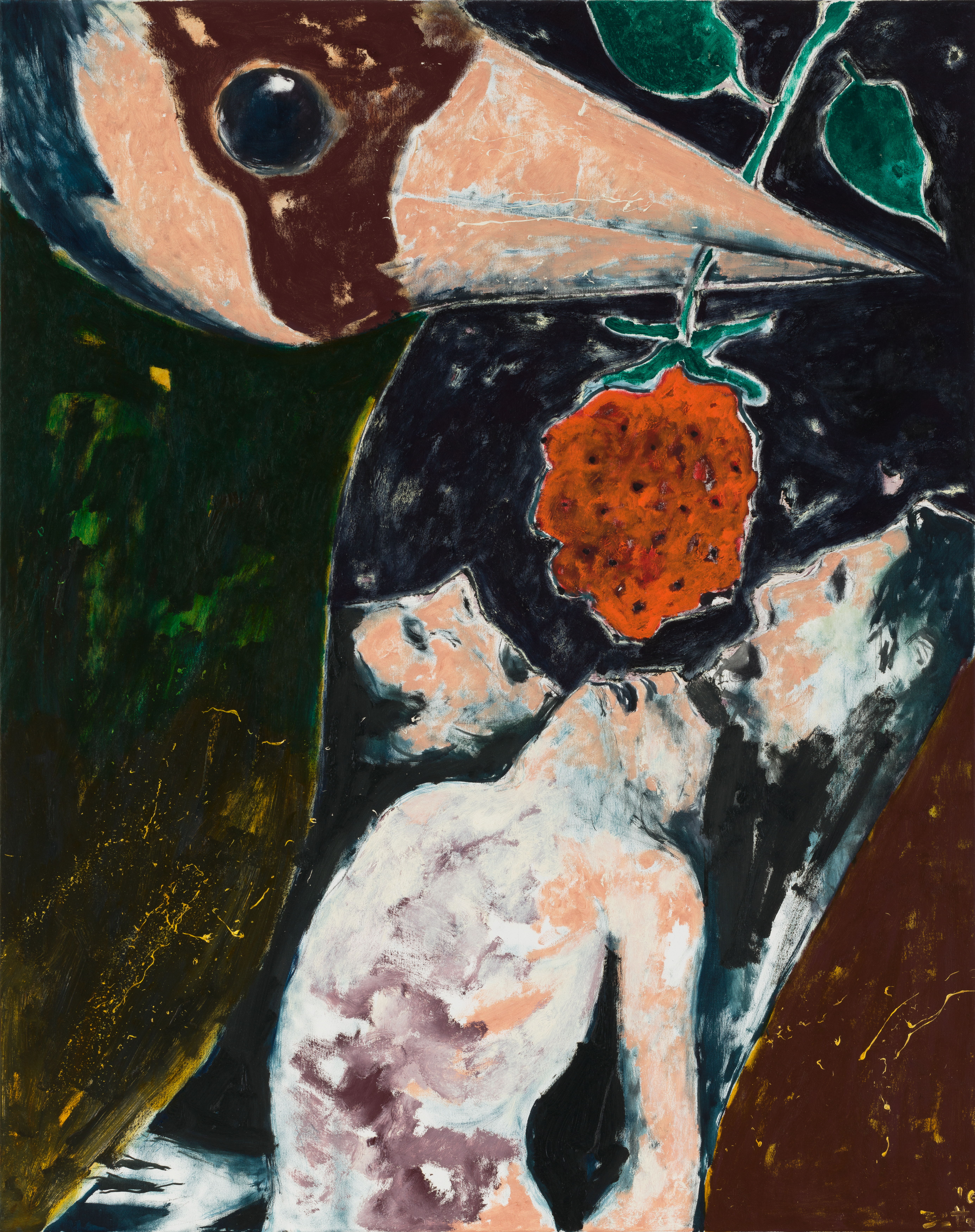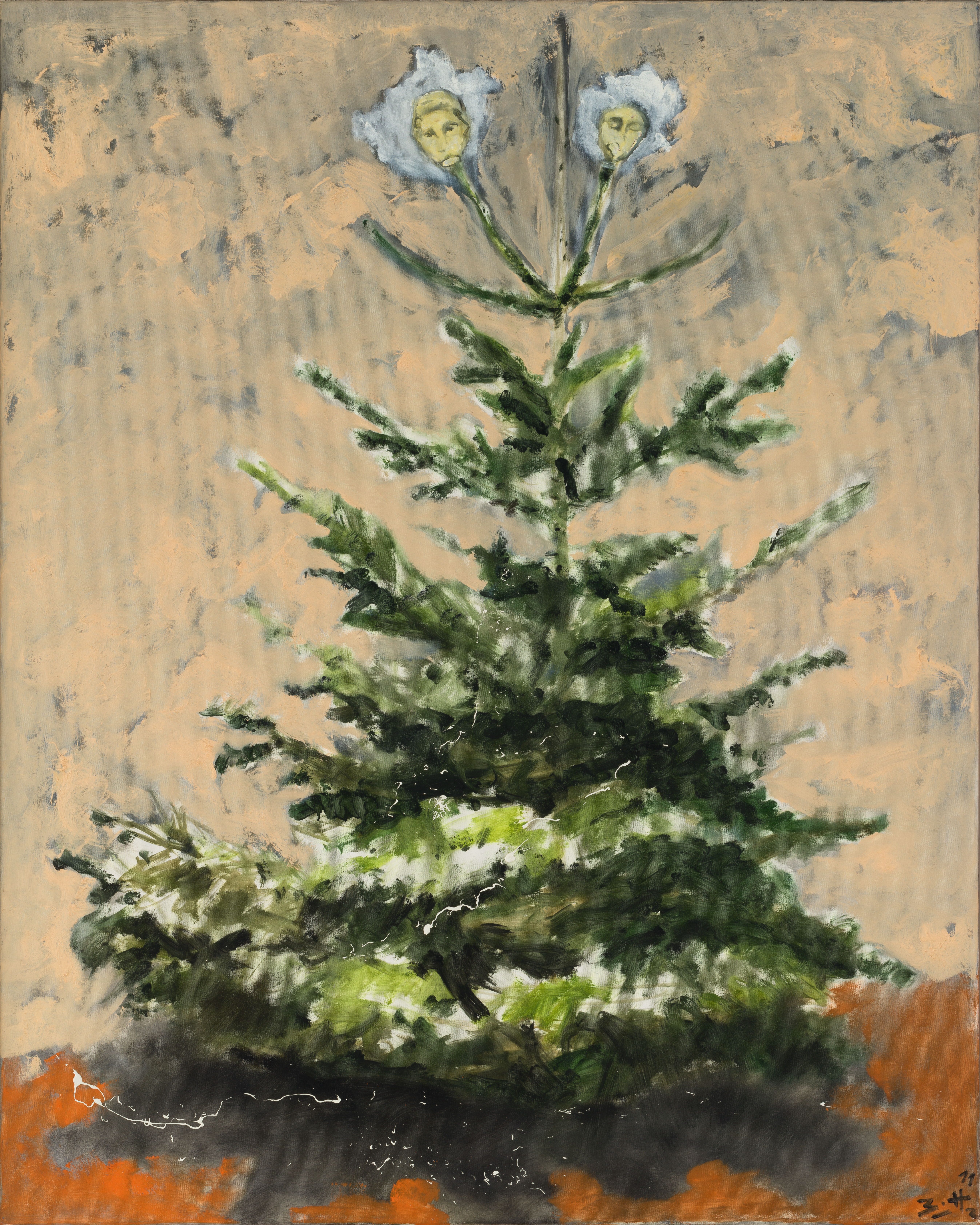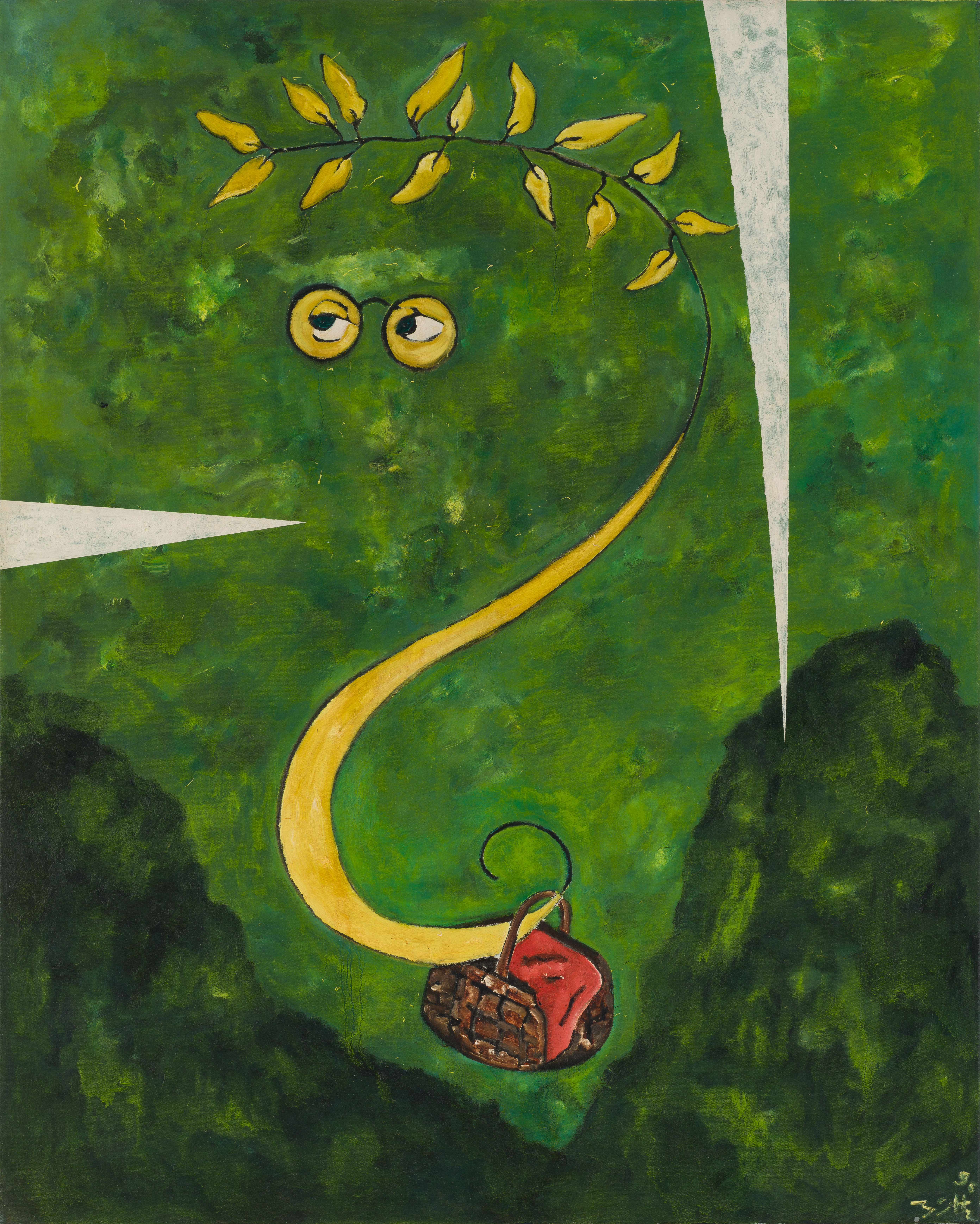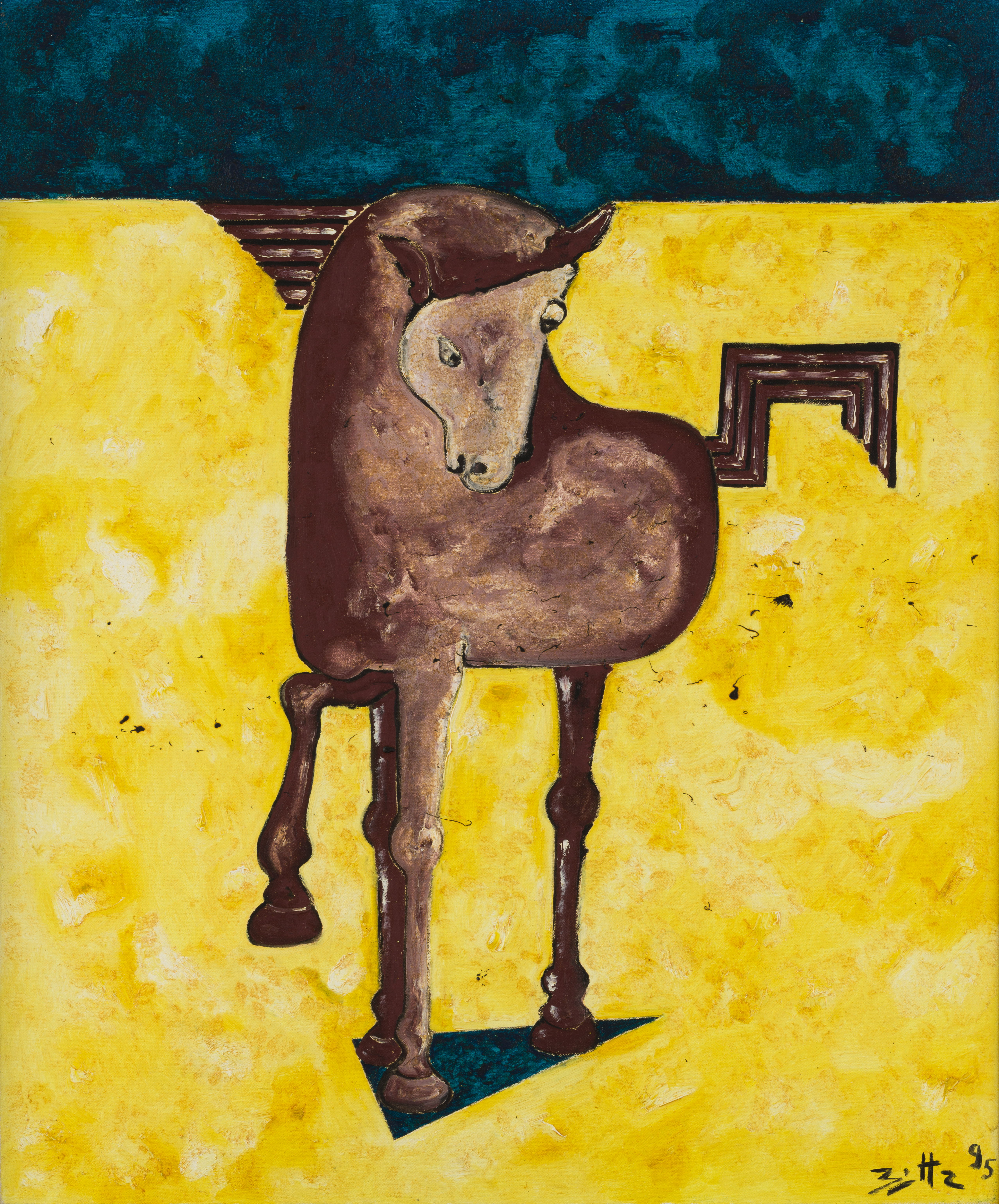|
Text by Curator: Werner Büttner – Irony Can Save the World
If Germany had a Literati Culture, the artist Werner Büttner could be considered one of the most prominent proponents. There is hardly any other artist in Germany, who is more well-read than him. Harald Falckenberg, a close friend of Büttner's, and one of the best collectors of contemporary art there, once said: "If Büttner had not become an artist, he would also have become a famous writer." The artist's field of interest is extremely wide. From the myths of early nomadic cultures to the skepticism of Montaigne's Essays, the artist has devoured Western philosophy and grand literature, not as an academic, but for personal use and as a means of developing his own personality. The human condition in all its glory and its misery is at the core of his interest and compassion. His intellectual curiosity and rigorous thinking are paired with a heightened sensibility for human strife. And all his artworks are witness to this uncompromising commitment to "La Condition Humaine."
Looking at Büttner's paintings at first is a puzzling experience. Many of his paintings are inhabited by strange animals in combination with wondrous ciphers that appear to carry references to meanings outside of the painting. For example, in Five Cranes and Charles Darwin's First Sketch on Evolution – Cranes? Actually, they were birds, the famous finches from the Galápagos Islands, that Darwin used to explain his theory "On the Origin of Species." Darwin nowhere writes about cranes, so why are they in the picture? – In 1995, the philosopher Daniel Dennett wrote the book Darwin's Dangerous Ideas in an effort to mediate the fight between Darwinists and Creationists in the United States. Creationists, he wrote, use "skyhooks" to explain the creation of nature. Darwinists only believe in the survival of the fittest. Dennett uses the analogy of "cranes" (the technical device, not the bird), a mechanism to lift the species from one level to the next. In his painting, Büttner conflates them both back into animals, staring back at the clueless audience, poking fun not only at the apparent idiocy of the ongoing debate in America, as well as the widespread gullibility – also that of the unwitting audience. He does so, using metonymic strategies ( exchanging one word / image for a similar one ), or metaphors (exchanging one word / image for something else completely ). In doing that, Büttner is " Attempting to Emblematize Existence" , as an early and important series of paper works are named.
What is an emblem? – As the encyclopedia states: "Emblems are based on the conviction that world events are full of discoverable, hidden meanings, and disguised references to meaning, and on the notion of the referential character of everything visible to a higher, inner, principled sense of world order." This approach to reality culturally peaked in Western Europe during Baroque times and was based on a broad consensus about the fixed meaning of the emblematic conflation of word and image.
This clearly is not the case today. So why is Büttner using this Methodology? – There seem to be two reoccurring traits in his work, deep irony that cautions you to never believe in anything you see, and a deep desire to keep meaning alive, despite its obvious dangers. Werner Büttner is a believer, a believer in nothing. He sees the world and its references as a quarry of sorts, from where he receives the building blocks of his pictorial world, and he sees connections where no one else has looked, like in Thank You France (for Monsieur Monet and Lascaux Cave). He also "loans" images from other artists like Goya, Magritte, or Hieronymus Bosch as evident in Our Daily Detail. An interesting painting by Büttner – because it shows, how he invests his attention. This time the big bird really is a finch – a European Goldfinch that holds a bramble over the heads of three minuscule men, trying to eat from it without using their hands. This is a detail from Bosch's chef-d'oeuvre. What Büttner does not show is Adam and Eve positioned to the right of the group. In other words, Büttner does not necessarily aim for the "important" or mainstream topics. He sees with clarity the details right next to everybody else's focus of attention. In doing so, he reveals much more of our reality than by going at it directly. Irony can save the world.
Werner Büttner (b.1954, Jena, Germany). Studied Law at Berlin Free University in 1973. Moves to Hamburg in 1977. Works with Georg Herold , Martin Kippenberger and Albert Oehlen from 1977 to 1985, was a professor at the Oil Painting Department of the Hamburg University of Fine Arts from 1989 to 2021. The artist lives and works in Geesthacht, Germany.
Werner Büttner's recent solo exhibitions include: "Last Lecture Show"(Hamburger Kunsthalle, Germany, 2021; Currently traveling to The Ranch, New York, USA, 2022), "No Scene from My Studio"(Simon Lee Gallery, UK, 2021), "Undichte Schlüssellöcher"(CFA Gallery, Germany, 2020), "Bilder 1979-2019"(CFA Gallery, Germany, 2020). Recent group exhibitions include: "Back then has always been now. Painting since 1947 reconsidered"(Hamburger Kunsthalle, Germany, 2021), "Works on paper 5"(Max Weber Six Friedric, Germany, 2021), "Der Goldene Reiter in Faustrecht der Freiheit aka Fox and His Friends"(Contemporary Fine Arts, Berlin, Germany, 2020), "Works on paper 5"(Max Weber Six Friedric, Germany,2020), "Works from the 1980s/Conceptual Photography"(Marlborough Gallery, USA,2020).
In addition, Butner's works are collected by many important institutions and foundations. Such as the Guggenheim Museum, USA; Cincinnati Art Museum, USA; FRAC, France; Hamburger Kunsthalle, Hamburg, Germany; Mumok-Museum Moderner Kunst Stiftung Ludwig, Austria; Harvard Art Museum, USA; Pinakothek der Moderne, Germany.
Born in Coburg, Germany, Thomas Eller studied art and humanities at the University of the Arts in Berlin and the Free University of Berlin, and from 1987 to 1995 he worked as a research assistant at the Social Science Center in Berlin. From 1995 to 2004 he lived in New York as an award-winning artist. Upon his return to Berlin in 2004, he founded the online art magazine on the platform of artnet.de and served as editor-in-chief and executive manager from 2004 to 2008. In 2008 and 2009, he was executive and artistic director of the Temporäre Kunsthalle Berlin. In 2014, he moved to Beijing. Also in 2014, he co-curated the exhibition "Die 8 der Wege" with 23 Beijing-based artists in Berlin. He now serves as the president of Randian Magazine. From 2018 to 2020 he was artistic director of the Taoxichuan China Art & Sciences Program in Jingdezhen, the world capital of porcelain in Jiangxi Province, and most recently an associate researcher at Tsinghua University. Currently he is one of the curators of the Guangzhou Triennial 2022. He is a member of AICA and CIMAM.
|
 |




